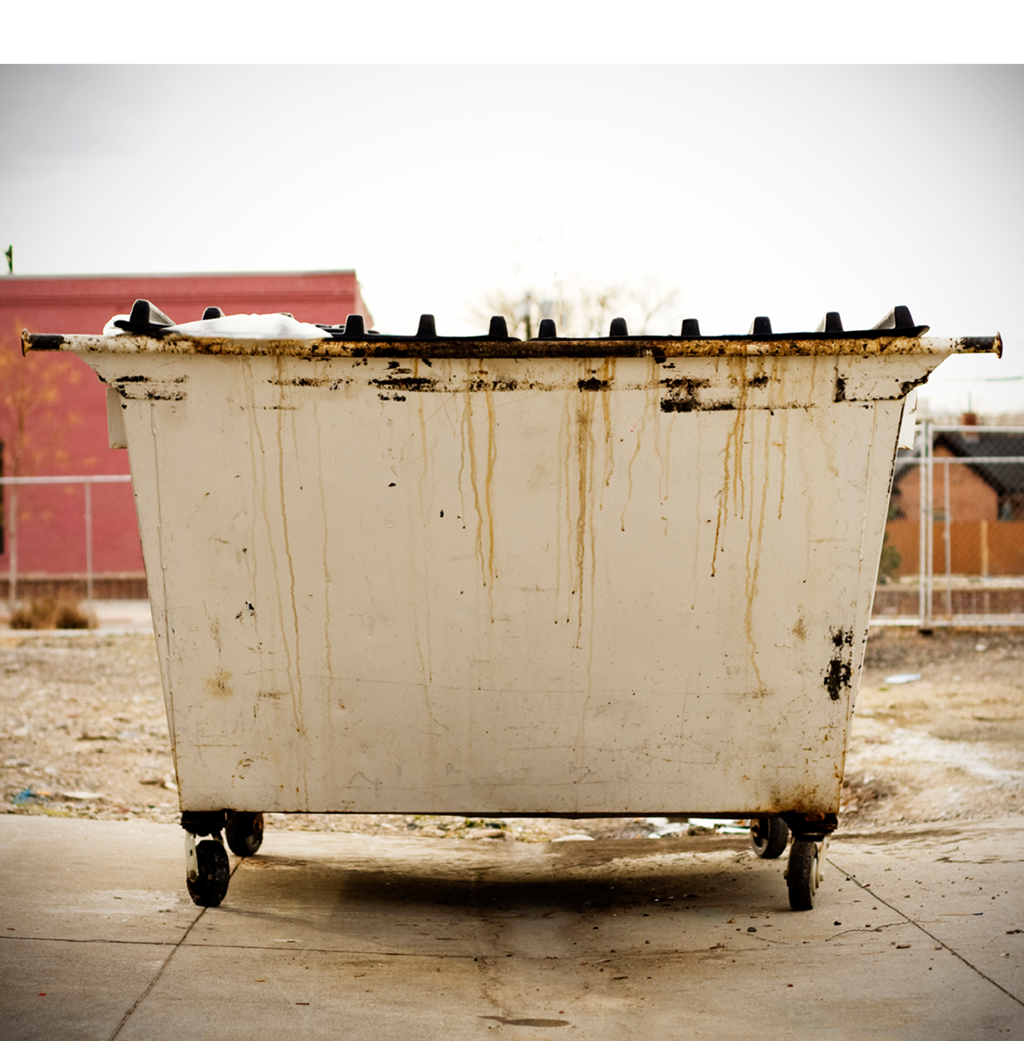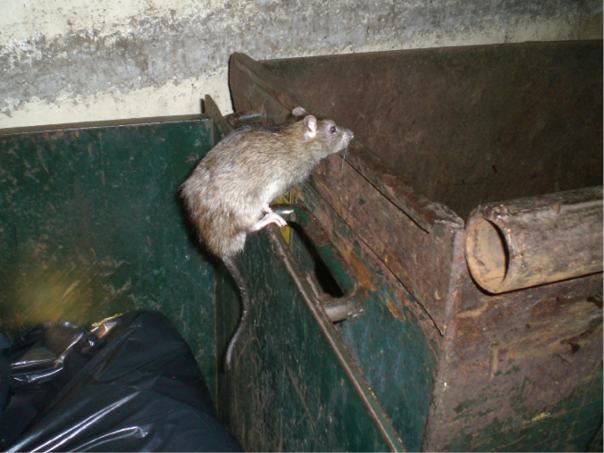
Pause for a moment and consider this question: How do the pest issues of many of your commercial food-related clients actually begin? We should try to focus on the moment — the actual moment — when the very first mouse or rat or fly occurs at a facility and, more importantly, where it is likely take place.
This article poses the likelihood that the genesis of many of our clients’ pest infestations originate where strong pest attractants meet easy pest entry opportunity. And, an all-too-common situation where this occurs is where food refuse dumpsters meet the nearest gappy door threshold.
So, how can we as pest experts, help our clients minimize such pest “startups”? Let’s consider this premise and outline some on-the-job tips that address this issue specifically.

FSEs, DUMPSTERS & PESTS. Commercial food-serving establishments (FSEs) (see Table 1) must employ relatively large refuse containers such as dumpsters/compactors to accommodate their food waste. Dumpsters are particularly strong pest attractants for three reasons: 1) they hold copious amounts of decaying food refuse; 2) they are often located in out-of-sight areas of buildings; and, 3) they are usually misused by employees causing spills and additional filth, therefore attracting even more pests to the site.
Several urban pests such as cockroaches, mice, rats and flies are all opportunistic foragers (see Figure 1). This means they tend to forage about searching for food and harborage cues and opportunities to increase their chances of survival. For sure, odors (food molecules) liberated from food waste during the decay process are usually easily detected and traced by these pests. The fact of the matter is that a food dumpster, depending on how it is maintained and where it is located, can generate billions of food-related molecules. These molecules constantly drift into the air and settle downwards and into the zones of those animals that forage close to the ground. Naturally, these animals are specialized for detecting and follow such food opportunities back to their sources.
The majority of commercial dumpsters are located in areas of buildings that are out-of-sight and out-of-smell for obvious reasons. Most of us know that these areas are referred to as “around back.” These zones tend to be the areas where there is less foot traffic, and often they are hidden behind gates, walls or within sheds. As a result, such areas tend to be highly attractive to cryptic urban pests because they are quieter, often shadowy and contain fewer movements being made by unknown animals (e.g., humans, pets) that might pose a danger to the pest itself.

And finally to this point, “taking out the trash” sounds like such a simple a task to most people that we actually fail to take any time to discuss and teach each other “how” to take out the trash. FSE employees are, more often than not, inclined to drag bags overloaded with food and liquid wastes along the ground and then sling them (vs. placing them) toward the “around back” dumpster. Sometimes the trash goes in; sometimes it misses and falls to the ground, creating a mess highly conducive to attracting even more pests. Sometimes the dumpster’s rain lid is closed, but often it is not. And, cleaning these smelly, gross containers/areas is typically avoided by all even though it is among the most important daily chores to ensure food safety!
THE NEAREST DOOR. Dumpsters are usually located around the back of food-serving establishments. Here too, are usually the delivery doors and for many restaurants, the “kitchen doors” (see Figure 2). So, the potential for problems is evident. The dumpsters attract the pests to the area, and if the doors are not properly pest-proofed (and how many are?), pests seize yet another opportunity for harborage within (or to also follow their noses to the foods emanating out from beneath those gappy doors).
Pest proofing a commercial door usually means the installation of professional door sweeps that contain stainless steel fabric meshes embedded within heavy-duty rubber encasements (see Figure 3). (See also Corrigan, R.M. 2015. Of Rodents and Doors. Pest Control Technology. Vol 43. Number 8. Pages 34, 36, 38, 42, 44-46.)
All of this adds up to an unfortunate formula for these areas to serve (literally) first as magnets for pests; and then second as entry opportunities to food-related establishments — producing the actual genesis of what is now likely to become that client’s pest infestation.
PREVENTIVE SERVICE. Unfortunately, many FSE managers and their employees mistakenly believe their pest infestations (however they may have begun) can be corrected solely through a monthly pest service that applies sprays, baits or traps. Worse, sometimes both the FSE client and the pest specialist will lazily place all the emphasis on the control of existing and future pests, by stressing exterior bait boxes flanking non pest-proofed doors and interior traps that are neatly “in place” to presumably capture all incoming mice (attracted by the dumpster) through those same gappy doors. Barely a word is presented between the parties relative to what is drawing the pests to the establishment, or by what means they are offered unchallenged entry.
And as many tenured pest professionals can attest, even when it is earnestly attempted to discuss the importance of interior and exterior sanitation and the correct pest proofing of holes and doors, the recommendations all too often receive weak responses and/or half-hearted attempts. Nevertheless, there are multiple things that can be done by both the client and the pest specialist (hopefully working in a partnership) to significantly address and negate the dumpster/nearest door threat.
Below, there is a “Dumpsterology 101 checklist” to that end. It is not all-inclusive by any means. However, it addresses the majority of mistakes/oversights made by the typical food service client as well as emphasizes the critical points for pest specialists to keep in mind while servicing FSE clients. (After all, it is usually the pest specialist who is blamed for any recurring pests caused by the mistakes made in sanitation and pest exclusion!)

SUMMARY. Many times, the actual “birth” of pest infestations associated with those FSEs listed in Table 1 occur at the FSE’s dumpster zones, and the birth of the interior invasion which we have been hired to correct — and more importantly keep corrected — is via the door nearest the dumpster zone.
If we don’t keep an eye on this critical sanitation/exclusion relationship for them, our own history has taught us that they either ignore it, are too busy to address it, or don’t elevate it to the importance it deserves, relative to pest prevention and food safety. Whatever the reasons, ultimately it circles back to us, the pest professionals, usually culminating in complaints, costly callbacks and/or cancellations.
The bottom line then for helping our food-related clients be partners in preventive food safety is the pest control axiom: Messy areas must be kept clean and doors must kept closed and tight. That being said, how can we as their pest specialists, not be “ologists” for dumpsters and doors?
Whenever you are servicing an FSE account, always pause to ask yourself, “What is the relationship between the dumpsters and the doors nearest the dumpsters?
The author is an urban rodentologist with RMC Pest Management Consulting, Briarcliff Manor, N.Y.
Latest from Pest Control Technology
- SiteOne Hosts 2024 Women in Green Industry Conference
- Veseris Celebrates Grand Reopening of the Miami ProCenter
- Rollins' 2024 Second Quarters Revenues up 8.7 Percent YOY
- Fleetio Go Fleet Maintenance App Now Available in Spanish
- German Cockroach Control Mythbusting
- Total Pest Control Acquires Target Pest Control
- NPMA Workforce Development Shares Hiring Updates
- Certus Acquires Jarrod's Pest Control





